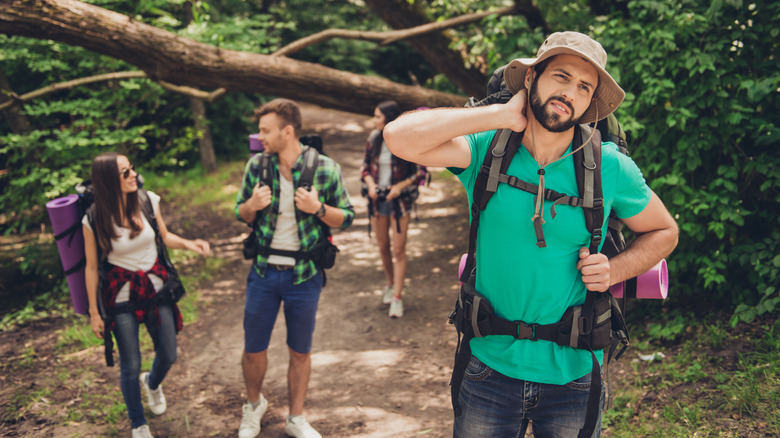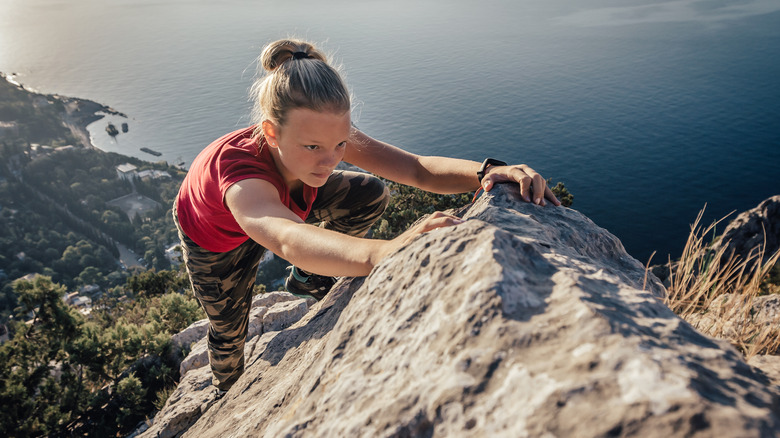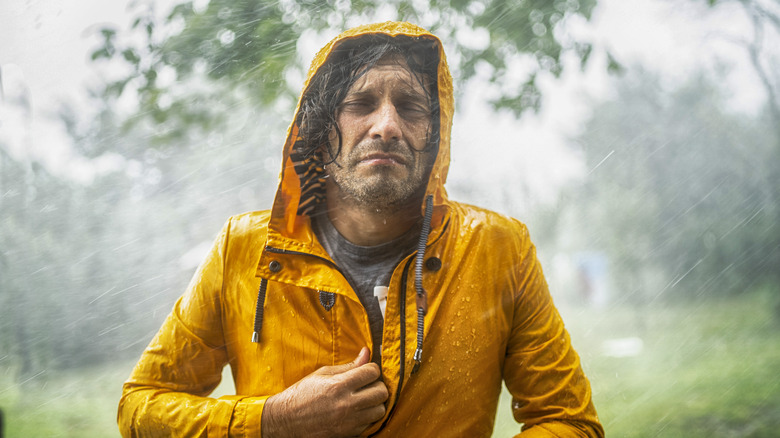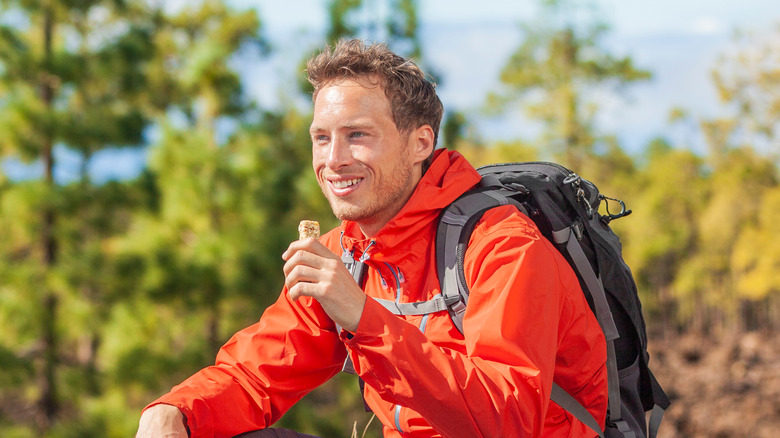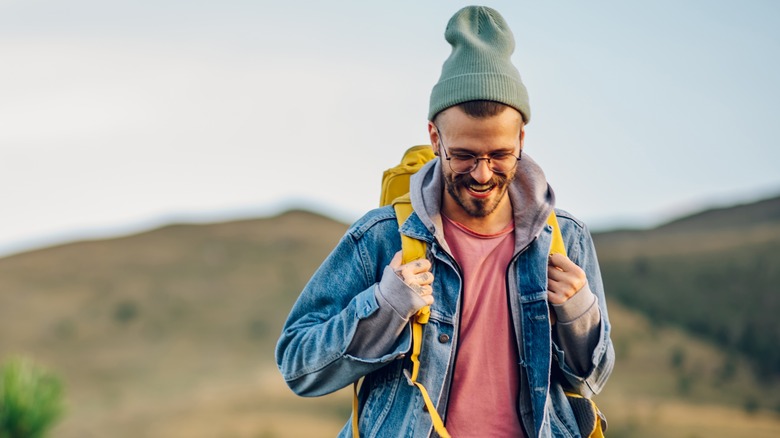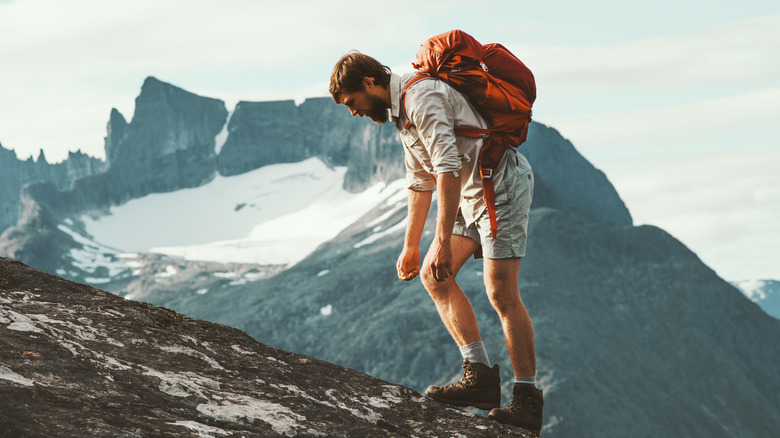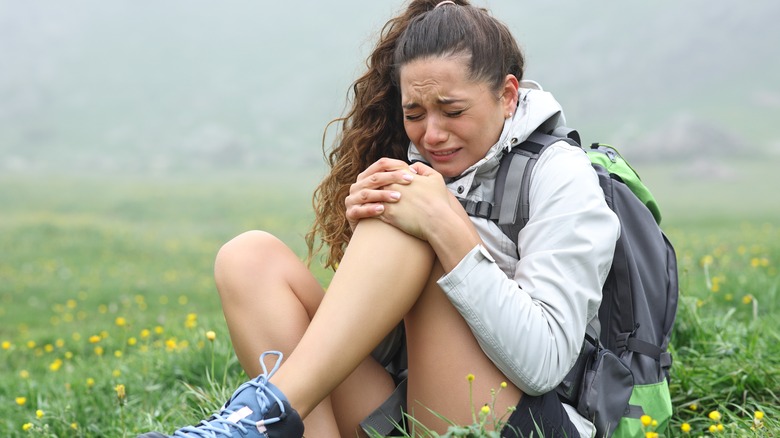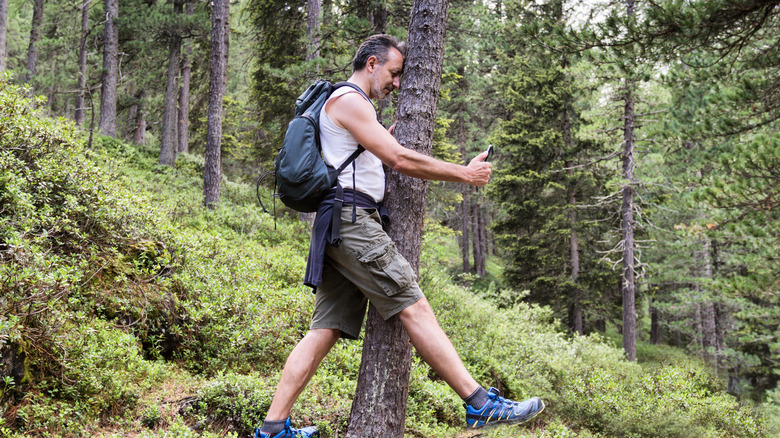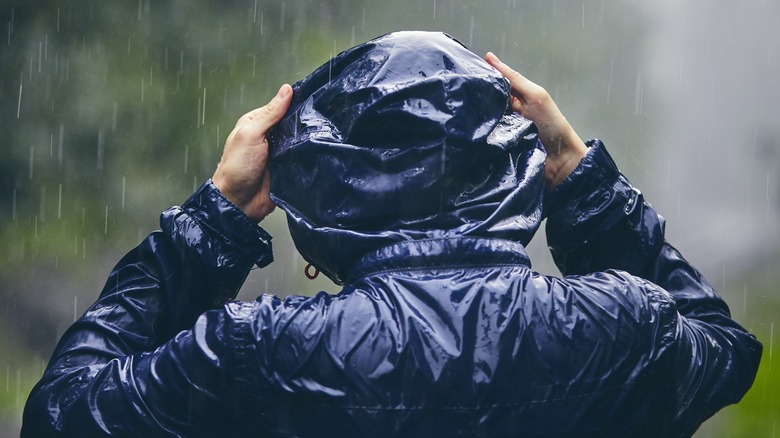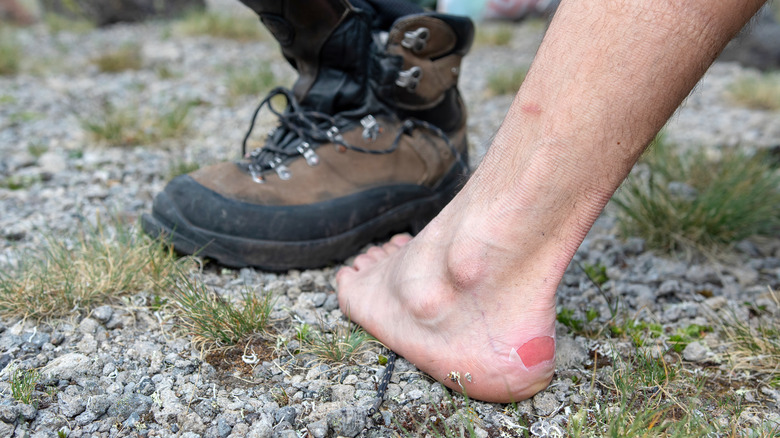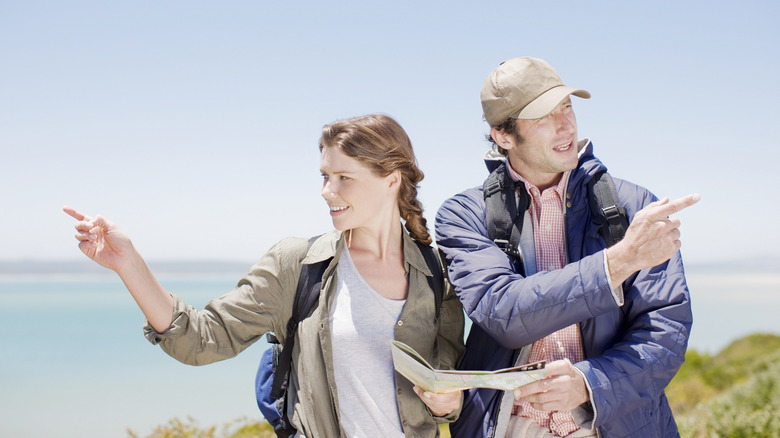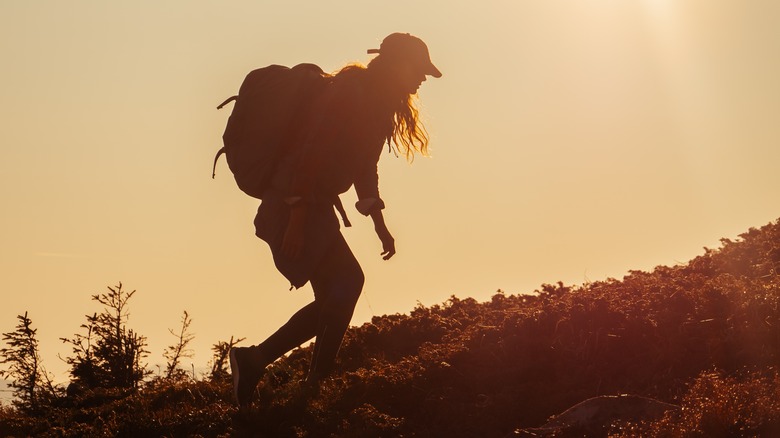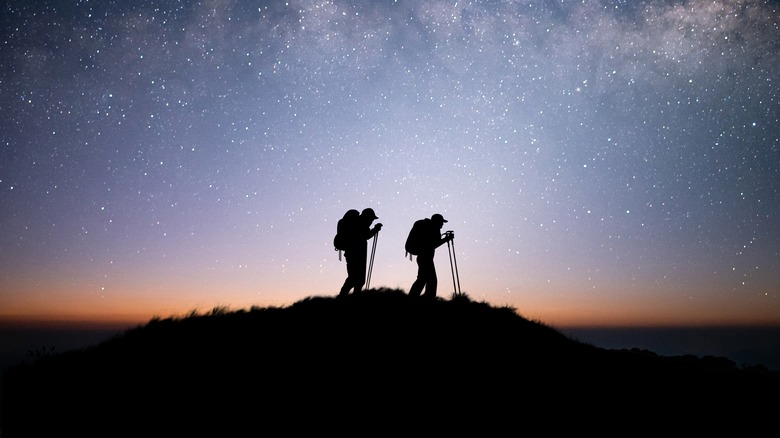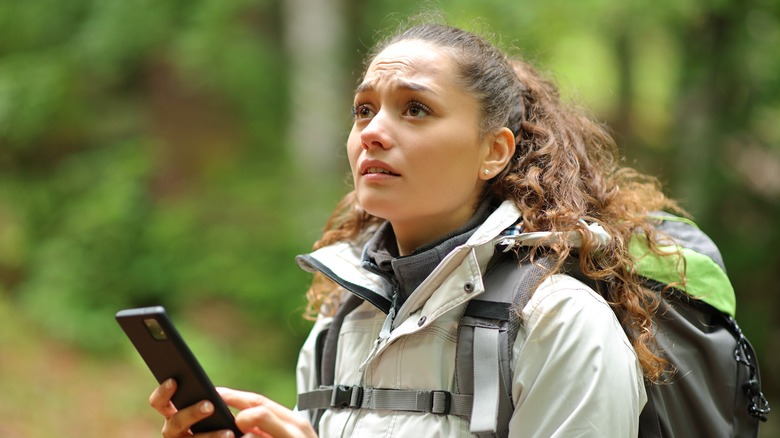Avoid Making These Massive Hiking Mistakes At All Costs
When set against the entire scope of human history, people haven't been hiking for leisure for very long. Not until the late 19th century and the dawn of the 20th century did hiking for recreation truly begin. Still, despite being a relative newcomer to the sporting world, hiking comes with its fair share of do's and don'ts. And while not everyone is going to walk the Appalachian Trail, there are certain hiking mistakes you want to avoid at all cost.
Make no mistake (pun intended), even a small, seemingly insignificant slip-up can cause a lot of headaches for a hiker. Some are physical, like wearing the wrong gear, or neglecting to treat blisters. Some are psychological, such as being overly ambitious, or hiking outside of your comfort zone. Others result from lack of forethought, like starting a long hike too late in the day or neglecting to check the weather.
Rest assured, falling into any one of these multiple traps could put you in serious jeopardy on the trail. The risk of injury, or even death, while hiking is all too real. So, pay attention to all of these massive hiking mistakes you should avoid at all costs. The information will save you when you're out on the trail.
Being too ambitious
As much as we like to think of ourselves as super humans, the reality is that we have our limits. One classic hiking mistake is having the hubris to think that we can handle anything nature can throw our way. Newsflash: we can't. Which is why, especially for those just getting started, planning an overly ambitious hike is a grave mistake that could have some pretty serious consequences.
The ability to metaphorically lose oneself in the beauty of nature is part of hiking's allure. As a result, we may be tempted to plan hikes that are far too taxing for our skill level or stamina. You need to know your limits when you are planning a hike. This is true even of the backpackers who make multi-day hikes look as easy as a hot knife slicing through butter. Hiking long trails riddled with difficult terrain is an exhausting affair. You could very easily overextend yourself. That exhaustion is going to lead to you make more of the mistakes on this list, some of which could result in serious injury.
Instead, plan a shorter hike, something in the vicinity of 2 to 3 miles on relatively level, even ground. It may not sound like much, but a few miles, even on easy terrain, is a lot of walking. Take things in stride, and know your limits. It is one of the best ways to avoid catastrophe.
Not checking the weather
This is a classic mistake that applies to numerous outdoor activities. When it comes to hiking, however, failing to check if there is a storm could lead to big trouble. Imagine being caught in gale-force winds as you are trying to hike down a trail. More than a few people have been caught in "surprise" storms while hiking and not made it out the other side alive. To show you what we mean, here's an example from the White Mountains of New Hampshire.
According to New Hampshire Magazine, Mt. Washington, the highest mountain in the northeast, has a known casualty rate of 161 people as of 2019. 33 of those people have been killed by hypothermia or weather exposure. That's not a small percentage. Mt. Washington serves as an excellent example of what can happen if you are underprepared for, or downright ignorant of, weather situations.
So, you ask, how can I prepare myself? You can get a detailed forecast of your area from the National Weather Service, but it also helps to have a good understanding of what happens to the weather and temperature as you ascend a mountain. Temperatures drop an average of 3 degrees Fahrenheit per 1,000 feet of vertical gain (via Backpacker). You can prepare by dressing accordingly, and understanding that a 3 degree change in temperature could mean the difference between clear, sunny skies or fog, rain, and snow.
Not having enough food or water
Not having enough food or water is a massive mistake. The depletion of energy caused either by not consuming enough food, or not having enough on hand, is a great way to speed up exhaustion. Perfect foods for hiking are those that are relatively lightweight, but nutrient dense. Think trail mix, fruit, nuts, jerky, or granola. These will help keep your energy levels up and sustained throughout your hike. More important than food, however, is water.
Dehydration is not a joke. In fact, it can cause you a great deal of harm in a very short amount of time. Becoming dehydrated while hiking can be a life-threatening situation if not handled quickly. Regardless of this fact, it can be tricky to figure out how much water to bring on your trip. You don't want to be overloaded, but you don't want to have too little either.
Here is a good tip to follow: pre-hydrate as much as possible before you leave. This way you won't have to carry too much water on the trail. While you're hiking, try to consume about two cups of water per hour. Most popular hiking locations should have a place for you to fill up your bottle or reservoir with safe drinking water. By making sure you have enough to eat and drink, you are ensuring a certain amount of personal safety while you're out in the wilderness.
Wearing the wrong gear
We've either been there ourselves, or we've seen them. Those folks heading out on the trail in flip flops or Uggs, and wearing jeans or baggy sweatpants. While experienced hikers will shake their heads and laugh at these folks, not understanding what kind of gear to wear is a mistake many hikers make. It's one mistake that could save you a great deal of aggravation and discomfort if avoided.
We will get into the proper type of footwear in a little while. For now, however, we're going to focus on something equally as important: clothing. The biggest hiking gear no-no you can commit is wearing cotton. Moisture clings to cotton like nothing else. This means that once it is damp, it will very likely stay damp. The presence of moisture decreases body heat, which is essential when hiking, especially if it is raining. A damp shirt or pants also makes things downright uncomfortable. Instead, you should opt for moisture wicking fabrics like wool or polyester.
Now, don't panic. If you don't have any specialized hiking gear, that's okay. Opt for the kind of clothes that you would wear at the gym, like joggers or yoga pants. The key is to be comfortable, while also protecting yourself by layering correctly. The last thing you want is to be caught in the rain without a means of staying dry.
Overpacking
Overpacking is a particular problem for newbie backpackers, but it applies to day hikers as well. Having a heavy, overloaded backpack is not going to make for a pleasant experience. Remember how much your shoulders and back hurt after carrying all those books on the walks to and from school? Multiply that by 10 and you have the agony that can be an overpacked hiking pack.
There are different packs designed for different types of hikes. The pack you choose, combined with the length of your hike, will dictate how you pack. If you are just going for a short day hike up your local mountain, a standard day pack, filled with just a few essentials, is the way to go. If you are hiking, say, the Pacific Coast Trail, you're going to need a bigger backpack that can hold more simply because you're going to need more things for your longer hike. Despite these backpacks being ergonomically designed to easily carry heavier loads, you should still err on the side of less.
That begs the question: what do I bring? It's all about balance. You want to carry enough essentials, like water, clothing, shelter, and first aid, to keep you fed and protected, but not so much that the pack becomes too heavy. Apply this principle to all backpacks for all levels of hiking. An overpacked backpack can lead to faster exhaustion, and potential injury from muscle strain.
Not having first aid
Murphy's Law applies to hiking first aid, and it goes thus: If you are not prepared for a hiking emergency to occur, a hiking emergency will occur. Nowhere will you be wanting first aid more than when you don't have it. It doesn't matter if you are nursing poison ivy, or bandaging a nasty cut from a fall. Knowing proper practices and having first aid equipment available will only benefit you. Help is not always quickly available in the woods.
It is worthwhile for everyone to learn the fundamentals of wilderness first aid (which is a combination of standard first aid practices) with the understanding that certain tools might not be available to you while you're out in the woods. Well stocked, portable first aid kits should always be brought on any hike, even if it's a trail you're familiar with. These kits will contain essentials like medical tape, antibacterial cream, alcohol wipes, wound dressings, ibuprofen, and more. Some may also include sewing needles, emergency fire starters, and loud whistles for flagging down help.
Know that proximity to first aid could be the difference between life and death in certain situations. Being able to disinfect and dress a wound before it's too far gone, or being able to tourniquet a broken leg, can make all the difference. So, do yourself, and others, a favor by being prepared for the worst.
Relying on GPS
Make no mistake, the global positioning system is an absolutely amazing tool. Having one at your disposal allows you to locate yourself without having to pull out a map and do all sorts of complicated orientations in order to locate yourself. However, the GPS comes with limits. There will be zones where you are left without a signal, and the battery will almost certainly go dead at some point, leaving you without a paddle. And what are you to do then?
Well, this is where those aggravating map reading skills will come in handy. Being able to read a map amounts to ascertaining specific navigational knowledge that prevents you from having an over reliance on modern technology. A map will not break down when you need it most, and they are more than usually as accurate, if not more so, than a GPS device.
The type of map all hikers need to be able to read and understand is the topographic map. These provide hikers with the most detailed analysis of the landscape, especially where elevations and depressions are concerned. Map reading is incredibly liberating, and prevents you from being too reliant on a GPS. Therefore, it is best to have both. Use the GPS when warranted, but make sure you've got a physical map as backup.
Not testing gear
One of the more silly mistakes you can make is hiking without properly knowing the actual quality of the gear you've purchased. You need to make sure that your gear is up to the task you are preparing to up it through. There needs to be a break in period for all hiking gear, especially shoes. But how do you do this?
Manufacturers will put their gear through a series of pressure tests before it even hits the shelf. You should be in the habit of doing the same thing. For example, if you have a new backpack, and you want to make sure it is sturdy, and will keep things from moving around, pack it and take it on a drive with you down a bumpy road. It'll slosh around, and, if you make a hard stop, fly from one end of the trunk to the other. Afterwards, check and see if what you packed moved around or if anything is broken. You'll get an idea of what it can handle if it should fall down a gradient while you're hiking.
You could do other things like wearing your rain gear in the shower, wearing your new hiking shoes on a day out shopping, or pitching your tent outside right before it rains to test the rain shell. By putting your gear through these tests, you are ensuring that they are up for the task when need be.
Being underprepared for blisters
Having the wrong footwear can lead to one of the most annoyingly painful hiking-related injuries: blisters. Obviously, blisters are not as serious as a broken foot. However, hiking for long periods of time with untreated blisters is going to cause tremendous pain and could potentially become infected. And the more you exert while you're in pain, the more exhausted you become.
Now, blisters do come in certain annoyance levels. For the day hiker, getting a blister is going to be a nuisance, but it is not going to take away from the entire hiking experience. For backpackers, however, blisters can become a nightmare. This is because, at the end of the day, a backpacker's hike is not finished. They will have to get up and walk many more miles the following day. So, how are blisters taken care of?
The key is to try and prevent them before they become an issue. Wear good-fitting boots with thin liner socks under your thicker hiking socks to start. If a hot spot — an early blister — starts to form, put protective padding over it immediately. If the blister pops, dress it as you would a wound and continue onwards. Proper treatment will yield proper healing, which will go a long way in negating further blistering.
Taking shortcuts
Though a shortcut may sound appealing, especially if you're nearing the end of a long hike, there are seldom actual shortcuts on a hiking trail. Quite the opposite, actually. Straying from the main trail is a great way to get yourself into a whole heap of trouble.
Whenever you traverse off the beaten path, the element of the unknown comes into play. In hiking, this has the potential to be very dangerous. A shortcut could mean anything from trying to cut down a slope instead of taking the switchbacks, or thinking you can get back to the parking lot quicker if you cut across what looks on the map like a straight diagonal through the woods. Realize that trails are cut in a specific way for a reason. They lead somewhere. Deviate too much and you open yourself up to unfamiliar terrain and the likelihood of an injury.
Another reason to avoid shortcuts is that, should you get in trouble, the rescue team is going to have a harder time finding you than if you had stayed on the trail to begin with. So, do yourself a favor and take the longer way. Yes, it will take a little longer to get back, but at least you won't open yourself up to unnecessary problems.
Choosing the wrong trail
Choosing the right hiking trail, especially if you are a beginner, is going to make a lot of difference towards the outcome of your hike. You want to consider a lot of things when it comes to choosing a trail. Take trail length, difficulty of the terrain, and the potential for scenery into account. It is also important to understand the dynamics of your fellow hikers if you plan on leading a group.
Keep in mind the experience levels of those in your hiking group. If you're all highly experienced, a steep, long trail is not going to be a problem. If, however, you have a mix of experienced and inexperienced hikers, make sure that you stick to a trail that caters more towards the inexperienced. A more difficult trail could cause them to flag, fall behind, become exhausted, and not enjoy themselves.
Being a beginning or inexperienced hiker is nothing to be ashamed of. Everyone starts at the bottom of the mountain. You need to build stamina and gain confidence in your abilities by starting on simple trails before taking on more serious hikes. The more you build your fitness and skills, the better off you are going to be when you eventually choose to take a more difficult hike. Doing one before you're ready, however, could be deeply discouraging.
Starting your hike at the wrong time
Another mistake that has gotten a lot of inexperienced hikers in trouble is starting their hike at the wrong time of day. It is easy to miscalculate exactly how long a hike will take, but there are certain times you should aim for. Morning and early to mid afternoon are the best times to go hiking. There is plenty of sun and the temperatures are not too dramatic in either direction. However, starting your hike in the late afternoon or early evening, especially in winter when light wanes faster, could make things difficult.
Unless you are experienced and have the right gear and light equipment, you should not go hiking after dark. Visibility is one of a hiker's chief tools. Not being able to see the terrain properly is going to open you up to a whole host of difficult situations. How many of us have trouble navigating our own surroundings enough during the day? Imagine trying to traverse roots and rocky ledges at night. It could lead to trouble in the form of a twisted ankle, or worse, that one wrong step.
It is best to stick to hikes during the times of the day when there is the most light. Avoid high noon in the summertime, however, because the higher temperatures could lead to increased dehydration and exhaustion.
Hiking outside your comfort zone
We come to perhaps the biggest mistake you can make of all: hiking outside of your comfort zone. Here is what this means. You should never, in any way, feel pressured to go on a hike that is out of your personal comfort zone. Steep gradients, ledges, and similar natural features are dangerous landscapes which, while offering potential for great views, can lead to tricky, sometimes life-threatening situations. It may not even be the case that you're uncomfortable with a trail, just a specific landscape.
There have been many experienced hikers who have become frozen with fear on the side of cliffs, and have needed to be rescued by emergency services. If you get an awkward feeling in the pit of your stomach about a certain landscape, or section of the trail, turn back. Your life is not worth majestic views or trying to prove something to your fellow hikers.
All of these mistakes can easily be avoided with forethought and practice. Hiking should be taken seriously by everyone who participates in the sport. This is the only way you will be able to ensure you are keeping in line with all of the safety and tranquility that a good hike can bring.
